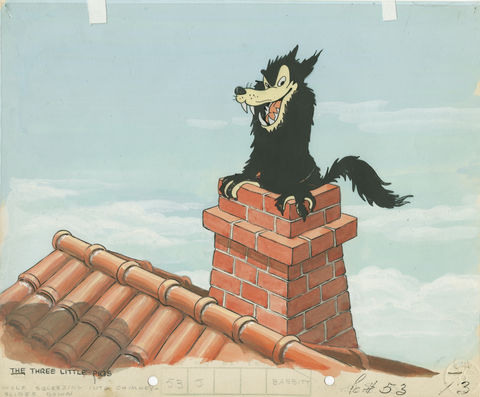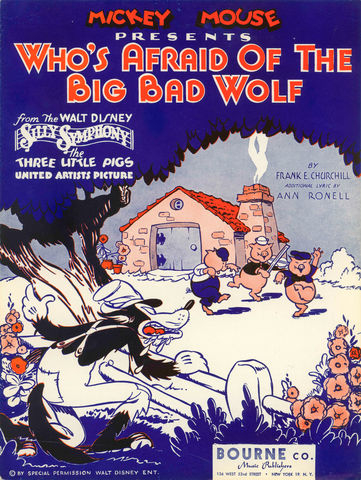In 1923, Walt and Roy O. Disney established the Disney Brothers Cartoon Studio with no fanfare and limited prospects. 10 years later, the situation was entirely the opposite. The Walt Disney Studios—as it was then known—had become the premier animation house in the United States, attracting talent from around the world, and elevating the art form from what had been a limited novelty into a major facet of world cinema.

Much of that success was thanks to Mickey Mouse, who had become an icon of popular culture. But simultaneously, Disney was experimenting with new stories and techniques with the Silly Symphony series. Today, this series of short cartoons is lesser known to general audiences, but 92 years ago in 1933, the studio released an entry that remains as iconic perhaps as anything Disney ever made: Three Little Pigs. The story was a well-known fable, but the execution was unlike anything seen before.
Walt himself would explain over 20 years later to journalist Pete Martin that he approached the production of Three Little Pigs as he would any other film. “I had been doing these things like [Father] Noah’s Ark [released 1933] with music,” he said. “United Artists had bought the Silly Symphonies with the provision that I had Mickey Mouse present them…. So I was building the Symphonies with a thing so I could broaden my whole business… where I didn’t have to be stuck in the groove and pattern of central characters…. So we were always experimenting. Each one was a new type of subject and something to give us a little something to reach out and accomplish something different.”
But as historian Michael Barrier would later explain, it seemed that Walt had a particularly significant experiment in mind for this newest film. “[...] There is good reason to believe that Disney saw Three Little Pigs as a special film,” he would explain. “In making it, he departed from patterns he had set in making his earlier films…”
It all came down to the development and animation of the distinct characters. “[We] might try to stress the angle of the little pig who worked the hardest, received a reward, or some little story that would teach a moral,” Walt wrote in a story memo. “Someone might have some angles on how we could bring the moral out in a direct way without having to go into too much detail. This angle might be given some careful consideration, for things of this sort woven into a story give it depth and feeling.” He emphasized that the pigs “will be dressed in clothes” and “not be kept in a natural state. They will be more like human characters.”

To accomplish this, Walt would cast specific animators to help bring these characters to life, a relatively new production method that allowed the individual artists creative oversight of their performances. Disney Legend Fred Moore was just 22 years old in 1933, but already was helping the Disney crew establish a new approach that would become widely identified as “personality animation.” Handling most of the key scenes of the pigs (Dick Lundy drew others of the pigs dancing), there was “no hint that [Moore] measured his pigs against real ones,” as Michael Barrier explained. “Instead…Moore drew fabulous animals that seemed to be made of flesh and blood. The pigs would have caught an audience’s eye for that reason alone, but Moore went further: he animated these seemingly solid little creatures with a plasticity that was new to Disney animation.”
Along with Disney Legends Norm Ferguson and Art Babbitt, who drew the Big Bad Wolf, the Disney animators found ways to imbue characters with believable movements more subtle and nuanced than what had been seen before. These performances opened the door for richer emotional connection. As historians Russell Merritt and J. B. Kaufman would note, “These characters were not simply moving drawings but individuals capable of endearing themselves to an audience.” With personality animation, Walt could tell more elaborate stories, perhaps ones that were feature length.
Central to the story of Three Little Pigs was “Who’s Afraid of the Big Bad Wolf?”, the irreverent song that became an anthem of resistance to the harsh realities of the Great Depression. According to Walt, however, the song’s societal impact “wasn’t intentional on our part.” He explained to Pete Martin how “it hit at the psychological moment. It hit in 1933 when everybody actually had a Big Bad Wolf at their door…. We just took it and made it a subject, you see?”

Written by studio musician and Disney Legend Frank Churchill, “Who’s Afraid of the Big Bad Wolf?” came at a time when Walt was frustrated with the challenges of licensing existing music to their cartoons. “[...] It was so expensive, I couldn’t afford it,” he explained. “And [there were] also the problems of clearing. If I wanted to use a certain tune, it would take me a month to clear it…. I got disgusted with it. So I had the musicians [and] I said, ‘To heck with it. Why don’t we write our own music?’”
Released in May of 1933, Three Little Pigs was a success that took practically everyone by surprise. It played in theaters for months-long extended runs, and was among the first Disney titles to be specially-dubbed and adapted for international release. Author Robert D. Feild would write just a handful of years later that “no one will ever know to what extent it may be held responsible for pulling us out of the Depression, but certainly the lyrical jeer at the Big Bad Wolf contributed not a little to the raising of people’s spirits and to their defiance of circumstances. It was the first great musical hit to come out of the Studio; the picture was the first of the Silly Symphonies to establish its reputation in the eyes of the world along completely new lines.”
For Walt, the experience of making the cartoon not only granted him essential advancements in animation and music, but also a memorable lesson in how to handle commercial success. “After Three Little Pigs made this tremendous hit, then [the distributor] came and said, ‘More pigs,’” he explained. “Before it was ‘more mice,’ so they said ‘more pigs.’ And I made a crack at that time that I think sums the whole darn thing up…. I was reluctant to do it and I said, ‘Well, I don’t think I can ever top pigs with pigs.’ And it’s true. Well, I went ahead and made more pigs, and there are very few people that’ll remember them…. The one that they all remember is Three Little Pigs…. It was the basic idea behind [it] that set the thing off.”

–Lucas Seastrom
Lucas O. Seastrom is a writer, filmmaker, and contracting historian for The Walt Disney Family Museum.
Image sources (in order of appearance):
- Poster - Three Little Pigs (1933), 1968 rerelease, 1968; collection of the Walt Disney Family Foundation, Gift of Dean Barickman; © Disney
- Cel set-up - Big Bad Wolf in chimney, Three Little Pigs (1933), c. 1933; Collection of the Walt Disney Family Foundation; © Disney
- Song sheet for the pop version of “Who's Afraid of the Big Bad Wolf”, Three Little Pigs (1933), 1933; Collection of the Walt Disney Family Foundation, Collection of Ward Kimball; © Disney
